Cook This: 3 recipes from the Balearic Islands, including steamed mussels with homemade mayonnaise
Make sun-kissed recipes from The Spanish Mediterranean Islands Cookbook
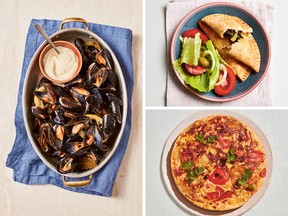
Article content
Our cookbook of the week is The Spanish Mediterranean Islands Cookbook by Barcelona and Menorca-based writer Jeff Koehler.
Jump to the recipes: farmer’s egg tortilla, steamed mussels with homemade mayonnaise and spinach-filled pastries.
A prolific author, Jeff Koehler has penned books on subjects as varied as Matisse in Morocco, wild coffee and paella. He divides his time between Barcelona and Menorca, and though Koehler started visiting the Balearic Islands in the late 1990s, it took him many years to come around to writing about them.
“I’ve been here for a long time, coming to the islands, and I never wanted to write about it,” says Koehler. “Suddenly, there’s nothing else I want to write about but here.”
The Spanish Mediterranean Islands Cookbook (Phaidon, 2025) is the first of its kind. Koehler was shocked that the book didn’t exist and, in the lead-up to the publication date, was nervous that someone would beat him to it. In more than 150 home-cooking recipes, he celebrates the resourcefulness at the heart of the food culture of the Balearic Islands: Mallorca, Menorca, Ibiza and Formentera.
When Koehler started visiting Menorca more than 25 years ago, he was surprised by how different it was from Spain’s mainland. Then, when he began travelling between the Balearics, he was struck by how distinct they are. Even Mallorca, which Koehler says can be seen on a clear day from Menorca, is markedly different. The challenges of growing food and surviving in the isolated, rocky landscape have tied the cuisines to each island in specific ways.
“Food is such a way into the culture. And people always ask me, ‘Oh, but Ibiza has a cuisine? It’s not just tapas from Spain?’ It’s like, ‘No,'” adds Koehler, laughing. “It’s really underknown.”
In The North African Cookbook (2023), Koehler compared the cuisines of the countries in the region. For The Spanish Mediterranean Islands Cookbook, his approach was similar. He references his friend, Toronto-based writer Naomi Duguid, and how she “loves to talk about how you draw your map. My map in North Africa was where couscous is a staple. And this map was a little bit more obvious because it’s very clear, but it’s a very defined map in that there’s a lot of influence from the Catalans and other places, but still, it’s very, ‘This is Menorca.'”
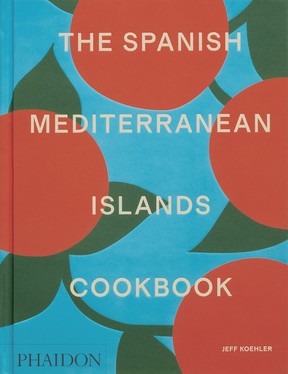
Because Koehler knew the island first and best, he initially looked at the rest of the Balearics through “the viewfinder of Menorca,” and started seeing the differences gradually. His observations mounted as he travelled more extensively in Ibiza and Mallorca. “That was a little bit of a turning point. I realized how spectacular those similarities and differences were and really wanted to tell that story.”
Even as someone who knows the islands well, each trip offered new insights. Spending a week in various places, such as Es Pla, a central agricultural region of Mallorca, gave him a sense of their individuality and how they developed.
Though Canadians without a connection to the islands may associate Ibiza solely with nightclubs and beaches, “Tourism is shooting upwards,” says Koehler. For example, the French are flocking to Menorca, which wasn’t as developed as Ibiza in the 1950s and ’60s, and the French edition of the book, La cuisine des îles Baléares, is getting a lot of attention. Cycling “is huge” in Mallorca’s Serra de Tramuntana mountain range and, from the food to the geography, “there’s something for everybody.”
The Balearics, as a group of four islands — not just Ibiza — are poised to break through as a top travel destination. “People often confuse Menorca with Mallorca or other islands. They don’t fully get it yet. It’s coming, though, for sure.”
Despite outside influences and increasing tourism, the Balearic Islands’ food culture remains. Avocado toast may be inescapable for brunch, but Koehler considers it an addition, not a substitution.
“People here still truly believe that they have one of the finest cuisines in the world,” he says. “People really love to eat the food here, and I don’t think that’s necessarily the case everywhere. There are a few dishes that people love. But people truly love the food of the islands, and people are also discovering that when they come.”
FARMER’S EGG TORTILLA
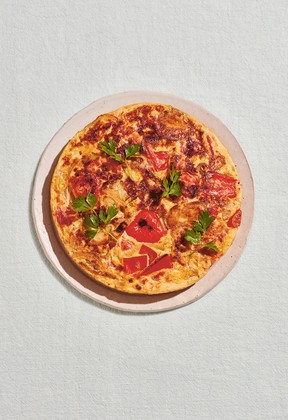
Serves: 4
4 tbsp olive oil, plus extra if needed
1 white potato, peeled and thinly sliced
1 yellow onion, thinly sliced
1 small or 1/2 large red bell pepper, stemmed, seeded and cut into generous pieces
1 tomato, cut into bite-size pieces
4 extra-large eggs
Salt
Step 1
Heat the oil in a 23-cm (9-inch) non-stick frying pan over high heat. Add the potato and fry until tender, 8-10 minutes. Transfer with a slotted spoon to a colander to drain off the excess oil and then transfer to a large bowl.
Step 2
In the same pan over medium-high heat, fry the onion and pepper until they begin to soften, about 10 minutes. Add the tomato and cook for 2 minutes. Transfer with a slotted spoon to the bowl, leaving as much oil in the pan as possible. Remove the pan from the heat.
Step 3
In a separate bowl, beat the eggs, season with salt and pepper and pour over the vegetables. Stir gently and let sit for a few minutes.
Step 4
The bottom of the pan should be lightly coated with oil; add a touch more if needed, or scoop some out if there is too much in the pan. Heat over high heat. Pour in the egg mixture and then immediately reduce the heat to low. Shake the pan so that the tortilla doesn’t stick. Cook until the eggs are nearly set and the tortilla can be flipped, 6-8 minutes. With the help of a plate, flip the tortilla: carefully flip onto the plate, then slide the tortilla back into the pan and cook until cooked through but still a touch juicy, 5 minutes.
Step 5
Transfer to a serving plate. Let cool for a few minutes before cutting into wedges and serving.
STEAMED MUSSELS WITH HOMEMADE MAYONNAISE
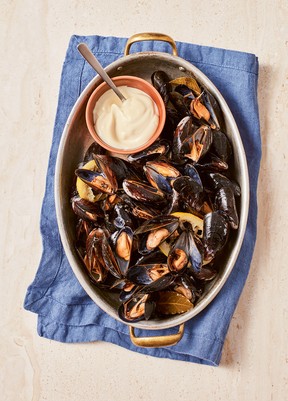
Serves: 5
Mayonnaise:
1 extra-large very fresh egg, at room temperature
Pinch of salt
1 tsp white wine vinegar or lemon juice
120 mL (1/2 cup) mild olive oil or a blend of olive oil and sunflower oil
Mussels:
Freshly made mayonnaise
2 bay leaves
2 lemon slices
1 kg (2 1/4 lb) small to medium mussels, cleaned
TO MAKE THE MAYONNAISE
Step 1
In a tall, narrow and cylindrical container just wider than the shaft of an immersion hand blender, mix the egg, salt and vinegar, and slowly pour in the oil.
Step 2
With the blender still off, put the blender shaft into the bottom of the container. Turn on the blender to three-quarter speed and begin blending. Once the emulsion begins to form, very slowly bring the blender up through the oil to the surface and then slowly back down to the bottom, and then up once more and out, about 30 seconds of total blending time. The mixture should be thick and creamy. If there is any oil pooled on the surface, turn the blender back on and lower the shaft slowly back to the bottom and out again.
Step 3
Transfer to a small bowl. Cover tightly with plastic wrap and refrigerate until ready to serve. Use the same day.
TO MAKE THE MUSSELS
Step 1
When you have prepared the mayonnaise, spoon into a small serving bowl, cover and refrigerate until ready to serve.
Step 2
In a large pot, combine the bay leaves, lemon slices and 120 mL (1/2 cup) water. Add the mussels, cover the pot and bring to a boil. Steam until the mussels have opened, shaking the pot from time to time, 3-5 minutes. Transfer with a slotted spoon to a large serving bowl, discarding any that did not open.
Step 3
Serve immediately with the mayonnaise.
SPINACH-FILLED PASTRIES
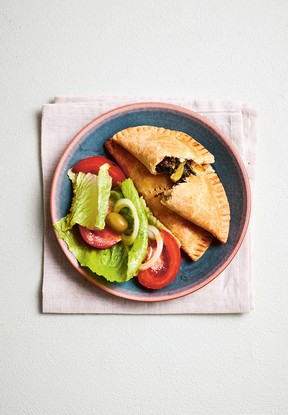
Makes: about 15 (13-cm/5-inch) stuffed pastries
For the filling:
700 g (1 1/2 lb) trimmed fresh spinach leaves
1 tbsp olive oil
1 yellow onion, finely chopped
2 tbsp seedless raisins (about 20 g)
2 tbsp pine nuts (about 15 g), dry-toasted (see note)
Salt
For the dough:
500 g (about 3 1/2 cups) all-purpose flour, sifted
2 egg yolks
150 g (2/3 cup) lard, at room temperature
60 mL (1/4 cup) mild olive oil
Pinch of salt
1 egg, beaten, for brushing
Step 1
Prepare the filling: bring a large pot of lightly salted water to a boil, add the spinach and boil until wilted, 2-3 minutes. Drain well in a colander and let cool, gently pushing out the excess moisture as it cools.
Step 2
Heat the oil in a frying pan or sauté pan over medium heat, add the onion and cook until soft, 8-10 minutes. Stir in the raisins and pine nuts and remove the pan from the heat.
Step 3
In a mixing bowl, combine the spinach and the onion mixture, then toss together and season with salt. Set aside.
Step 4
Prepare the dough: put the flour in a large bowl and make a well. Add the egg yolks, lard, oil and salt, and begin mixing, with either a spoon or your hands, gradually adding 120 mL (1/2 cup) water. Knead until it forms a smooth and supple ball.
Step 5
Preheat the oven to 180C (350F). Line several oven sheets with parchment paper. Put the beaten egg in a cup.
Step 6
On a clean work counter, lay out a large sheet of baking paper. Take a piece of dough (about 70 g/1/4 cup) and roll it out on the baking paper until 5 mm (1/4 inch) thick. Use a smallish round bowl (12-13 cm/4 1/2-5 inches in diameter) to press out a circle. Trace around the circle with a knife and pull away the excess dough.
Step 7
Place about 30-35 g (scant loosely packed 1/4 cup) of the filling in the centre. Moisten the edges of the pastry with water and, lifting up the baking paper, fold over to form a half-moon. Lightly press the edges together with your fingers. Using the tines of a small fork, press down along the edges. Gently place on one of the baking sheets. Repeat until you have used the remaining dough and filling.
Step 8
Prick the tops of the pastries in a few places with the tines of a small fork. Brush with the beaten egg.
Step 9
Bake the pastries in the hot oven until golden (don’t let them darken too much), about 25 minutes. Remove from the oven and let cool.
Step 10
Store in sealed containers. Best eaten within 3 days.
Note: To fully draw out their rich, nutty flavours, pine nuts should be dry-toasted in a small ungreased frying pan over medium-low heat for a couple of minutes until aromatic and golden. Stir frequently while toasting and immediately transfer to a plate to stop them from cooking further.
Recipes and images excerpted from The Spanish Mediterranean Islands Cookbook ©2025 by Jeff Koehler. Photography ©2025 by Simon Bajada. Reproduced by permission of Phaidon. All rights reserved.
Our website is the place for the latest breaking news, exclusive scoops, longreads and provocative commentary. Please bookmark nationalpost.com and sign up for our cookbook and recipe newsletter, Cook This, here.














Postmedia is committed to maintaining a lively but civil forum for discussion. Please keep comments relevant and respectful. Comments may take up to an hour to appear on the site. You will receive an email if there is a reply to your comment, an update to a thread you follow or if a user you follow comments. Visit our Community Guidelines for more information.